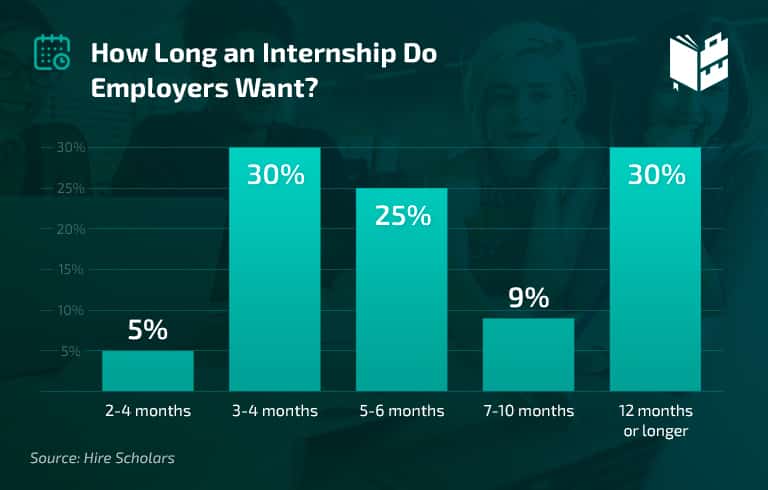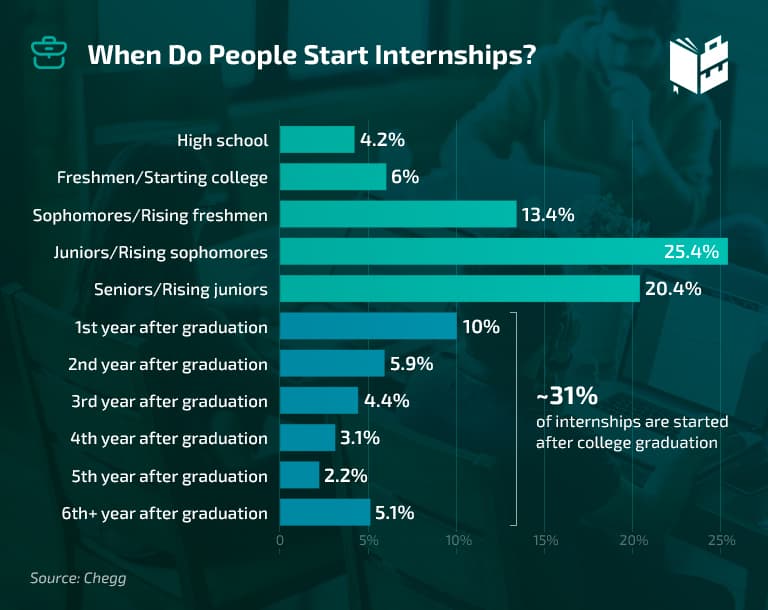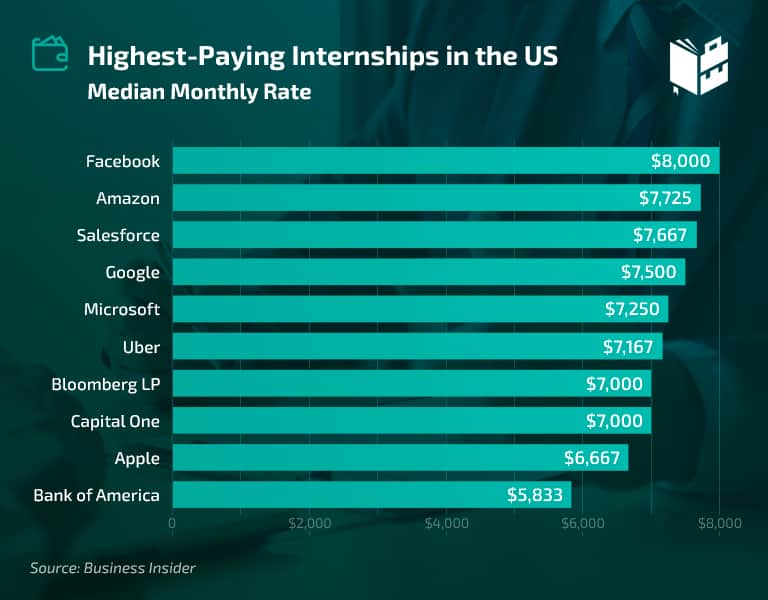Having experience as an intern increases your chances of finding a well-paid job. Therefore, internship statistics will help you gain more insight into internship programs and possibilities.
Unfortunately, most companies put a halt on their internship programs in 2020 due to the global pandemic and its effects on the whole world. Even so, many students are searching for internship opportunities that will increase their chance of employment in years to come.
Without further ado, let’s delve deeper into useful stats and facts about internships.
Top Internship Facts (Editor’s Choice)
- Internship experience has a 4.6 influence rating on the employers’ hiring decisions.
- Completing internships increases job offers by 16%.
- Employees with internship experience have a 9–12% higher salary than those without it.
- 31% of people do internships after they graduate from college.
- Tech companies provide 44% of the top-paying internships in the US.
- Over 40% of all internships are unpaid.
- Companies converted interns into full-time workers at a 51.8% rate in 2020–21.
- 30% of junior and senior college students’ internships were canceled in 2020.
The Value of Internships
There are many opinions about internships, and many people are not sure whether to go down that road. If you’re an aspiring intern, these statistics should help you make an informed decision.
1. Internship programs generally last up to three months.
(Hire Scholars)
The length of internships is important because interns should have enough time to adjust and learn. Most enterprises and schools agree that the average internship length is somewhere between three and four months. However, this time frame can be shorter or longer, depending on the internship program itself and employers.

2. 70% of interns whose internships were canceled are considerate of employers’ situations due to COVID-19.
(Yello)
COVID-19 took a toll on everyone, especially businesses and their operations. As statistics on internships show, 70% of students were disappointed because their internships got canceled but understood what employers were going through. On the other hand, 26% of students were not happy with the decision, while 4% were relieved that they didn’t have to be in close contact with people.
3. Individuals with internship experience say they have a 9–12% higher salary than those without it.
(Compare Camp)
By doing internships at respectable companies, individuals acquire skill sets that will influence their careers in the future, including their salary. As per college internship statistics, graduates who have internship experience earn $2,082 more per year than those without internship experience.
4. Doing internships boosts the chances of getting job offers by 16%.
(Compare Camp)
Individuals who have successfully completed at least one if not more internships get 1.17 job offers on average. This number is significantly higher than the average job offers those without interning experience get, according to internship stats. In fact, it’s 17.6% more than the average number of jobs students without experience got.
5. 31% of people start doing internships after they graduate from college.
(Chegg)
When talking about interns, many people consider them to be college students who still haven’t earned a degree. Contrary to popular belief, not all interns are students. Roughly 31% of interns start doing internships after graduation, as intern statistics show.

6. 30% of junior and senior college students’ internships were canceled in 2020.
(Compare Camp)
2020 was a challenging year for all of us. Changes and adjustments had to be made so that we could all stay protected. As a result, many internship programs were affected by the global pandemic. Almost one-third of internships got canceled in 2020, according to internship statistics.
7. Internship experience within the hiring organization has a higher influence rating on the employer’s decision while hiring than the experience within the industry.
(Compare Camp)
There are several factors that employers take into account when hiring an applicant. As hiring statistics show, employers are more inclined to hire applicants who completed internships within the organization than those who completed internships within the industry. Internship experience within the organization had a 4.6 influence rating on the employer’s decision compared to the same experience within the industry with a 4.4 influence rating.
Internship Statistics
Being aware of your chances of getting accepted as an intern and what percentage of internships are paid or unpaid are essential pieces of information when deciding on enrollment in such programs. As such, we’ve compiled a list of statistics, focusing on companies and salaries they offer and the chances of getting hired after completing your internship.
8. More than 40% of all internships are unpaid.
(CNBC)
When talking about percent of paid vs. unpaid internships, many legal experts consider unpaid internships to be not only unfair but also illegal since interns are required to work long hours without compensation. Ultimately, these unpaid internships exist because the overall benefits a student reaps far outweigh the benefits that a company gains.
9. Between 500,000 and one million Americans work as unpaid interns every year.
(Compare Camp)
Looking into internship trends, there’s an average number of 0.5–1 million Americans working as unpaid interns every year. This is due to the fact that having internship experience helps you get a good job a lot easier. As such, internship programs are sought-after, even if they’re unpaid.
10. Students of color are more likely to get hired for unpaid internships.
(Inside Higher Ed)
According to a 2019 survey’s unpaid internship statistics, African-American graduates received 6% paid and 7.3% unpaid internships. The National Association of Colleges and Employers wrote about racism in the workspace, how it isn’t a problem that developed overnight, and how it affects internship programs.. It’s a problem we’ve been facing for decades despite all the efforts to improve the situation.
11. Tech companies provide 44% of the top-paying internships in the US.
(Business Insider, Chegg)
Working while in college statistics show that although almost half of the best-paying businesses are tech companies when it comes to internships, these firms prefer hiring individuals who interned at some point. 80.2% of recent hires at Facebook had already completed internships before they got hired.
12. Facebook interns earn a median monthly pay of $8,000.
(Business Insider)
The multi-billion company is still one of the most popular social media platforms all around the globe. As such, it’s no wonder that the world-famous social media company’s average internship salary is $8,000. In 2019, Facebook had the best-paid internship program in the US.

13. The median rate per month Amazon rewards its interns is $7,725.
(Business Insider)
As one of the top ecommerce companies around the world, Amazon is not lagging far behind Facebook. This tech company had the second-best paid internship program in 2019, with a median salary of $7,725 per month, according to intern statistics.
14. Google pays interns a median monthly salary of $7,500.
(Business Insider)
Google LLC is third on the highest-paying internships list. The multinational technology company offers many benefits when it comes to learning useful skills while also compensating its interns with an average monthly rate of $7,500.
15. About 750,000 women work as interns each year.
(Compare Camp)
As seen from internship demographics, there are around 750,000 female interns yearly, and many are unpaid. Let’s say that’s acceptable when companies make an effort to teach interns valuable skills, but it’s a whole different story when they use them as free labor.
16. Roughly 400,000 women are likely to become victims of sexual harassment at the beginning of their careers.
(Compare Camp)
Sexual harassment is a big problem women worldwide face almost daily, especially when we look at internships statistics. Unpaid female interns are even more vulnerable. They aren’t employees and, therefore, aren’t protected by federal law. Things don’t change much after they get employed. As sexual harassment statistics show, around 615,000 women experience or see this type of abuse as they start to work.
17. The conversion rate for 2020–21 interns is 51.8%.
(NACE)
Converting interns into full-time employees is one of the things big corporations consider when launching their internship programs. However, employment internship statistics show that the offer (68.3%) and acceptance rates (75.5%) for full-time intern positions dropped significantly compared to the previous academic year.
18. 84% of students are willing to participate in a remote internship program.
(Compare Camp)
Despite many restrictions due to the global pandemic, most companies found ways to make internships work. Considering the benefits of internships for employers, many businesses switch their on-site internship programs to remote programs, which got mixed reactions from students.
Conclusion
Not everyone sees internships the same way. Some think they’re amazing opportunities, while others are convinced they’re fruitless. Ultimately, gaining work experience through internships seems to be the best way to go about it. No matter if they are paid or unpaid, the impact of internships on career outcomes is positive. Internship programs are designed to prepare interns for their careers, putting them at a greater advantage than other candidates.
As an intern, you familiarize yourself with the working environment while learning useful skills along the way. By completing at least one internship and acquiring crucial skills, you will increase your overall chances of getting hired by big companies in the future.